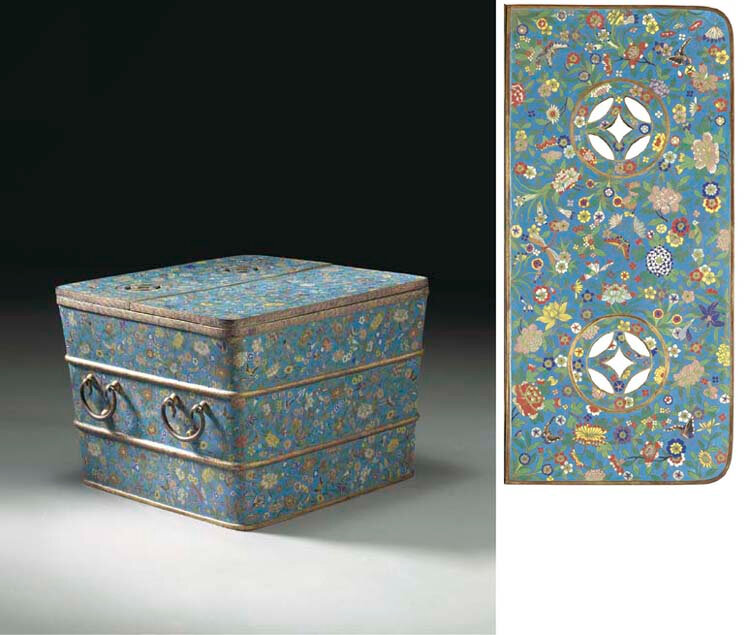A rare large Chinese Imperial cloisonné enamel square ice chest, Qianlong period (1736 - 1795)
Lot 601. A rare large Chinese Imperial cloisonné enamel square ice chest, Qianlong period (1736 - 1795); 27 1/8 in. (68.8 cm.) square, 19¼ in. (48.9 cm.) high. Estimate USD 40,000 - USD 60,000. Price realised USD 567,500. © Christie's Images Limited
The deep tapering sides decorated with a dense pattern of butterflies and insects in flight amidst scattered flowers divided into three registers by two ribs inlaid with polychrome enamel lotus scroll, the middle register fitted on two sides with two pairs of C-scroll handles with knocking bosses beneath, with a key-fret band at the rim and another around the rim of the similarly decorated, two-part hinged cover, one side pierced with two cash motifs for the emission of chilled air, the interior lined with pewter and wood, wood stand.
Note: Large ice chests of this type were used in the Palace during the hot summer months. They were filled with ice and placed in certain rooms used by the Imperial family. The ice was used to cool drinks, fruit and sweet snacks, as well as cooling the surrounding area and somewhat alleviating the oppressive heat of Beijing, which the Manchu emperors found so uncomfortable. While usually placed on stands, like the current example, these chests were sometimes placed directly on the floor beneath tables to cool both the food and those seated at the table. In winter ice blocks were cut from the Inner Golden River and were stored in the five ice vaults in the Forbidden City near the Gate of the Great Ancestors. These ice vaults could hold about 20,000 blocks of ice. During the period from the first day of the fifth month to the twentieth day of the seventh month specific members of the Imperial Household Department received an allocation of two blocks of ice per day. Surviving records indicate that originally the ice chests were made of wood, and usually lined with lead, like the example in the Victoria and Albert Museum illustrated by C. Clunas in Chinese Furniture, London, 1997, p. 99, no. 89, or lined with zinc as in the case of the example in the Musée Guimet illustrated by M. Beurdeley, Chinese Furniture, Tokyo, 1979, p. 95, no. 130. However, by the 18th century ice chests destined for the apartments of the empress and dowager empress are recorded as being made of plain bronze with pewter linings. It has been suggested that fine cloisonné enamel ice chests like the current example would have been intended for the emperor's apartments.
One of a pair of cloisonné enamel ice chests in the collection of the Palace Museum, Beijing is illustrated in The Complete Collection of Treasures of the Palace Museum - 43 - Metal-bodied Enamel Ware, Hong Kong, 2002, p. 134, no. 129. The Beijing ice chests, which bear a six-character Qianlong mark (AD 1736 - 95), share with the current example the three horizontal divisions and two handles at each end. Both chests also have hinged lids and two coin-shaped piercings on one half of the lid. The double handles at either end of the current ice chest and the Beijing Palace example would have been necessary in order for the vessel to be carried, since it would have been extremely heavy when full of ice.
The delicate design of flowers and butterflies on the current ice chest is effectively disposed over the top and sides of the chest, and each element is beautifully executed. A cloisonné enamel vase in the Beijing Palace Museum has a similar design of flowers and butterflies to that on the current ice chest, ibid., p. 100, no. 97. The vase, which has a six-character Qianlong mark, also has a turquoise ground similar to that of the ice chest. A Qianlong cloisonné ice chest decorated with shou characters, cranes and bats was sold Christie's, Hong Kong, 29 - 30 April 2001, lot 578.

/https%3A%2F%2Fprofilepics.canalblog.com%2Fprofilepics%2F1%2F0%2F100183.jpg)
/https%3A%2F%2Fstorage.canalblog.com%2F03%2F02%2F119589%2F96711876_o.jpg)
/https%3A%2F%2Fstorage.canalblog.com%2F11%2F31%2F119589%2F94773502_o.jpg)
/https%3A%2F%2Fstorage.canalblog.com%2F20%2F83%2F119589%2F94772815_o.jpg)
/https%3A%2F%2Fstorage.canalblog.com%2F26%2F72%2F119589%2F75604929_o.jpg)
/https%3A%2F%2Fstorage.canalblog.com%2F59%2F60%2F119589%2F26458628_o.jpg)



/http%3A%2F%2Fstorage.canalblog.com%2F05%2F64%2F119589%2F129847966_o.jpg)
/http%3A%2F%2Fstorage.canalblog.com%2F32%2F99%2F119589%2F129836631_o.jpg)
/http%3A%2F%2Fstorage.canalblog.com%2F42%2F50%2F119589%2F129607037_o.jpg)
/http%3A%2F%2Fstorage.canalblog.com%2F42%2F65%2F119589%2F129440589_o.jpg)